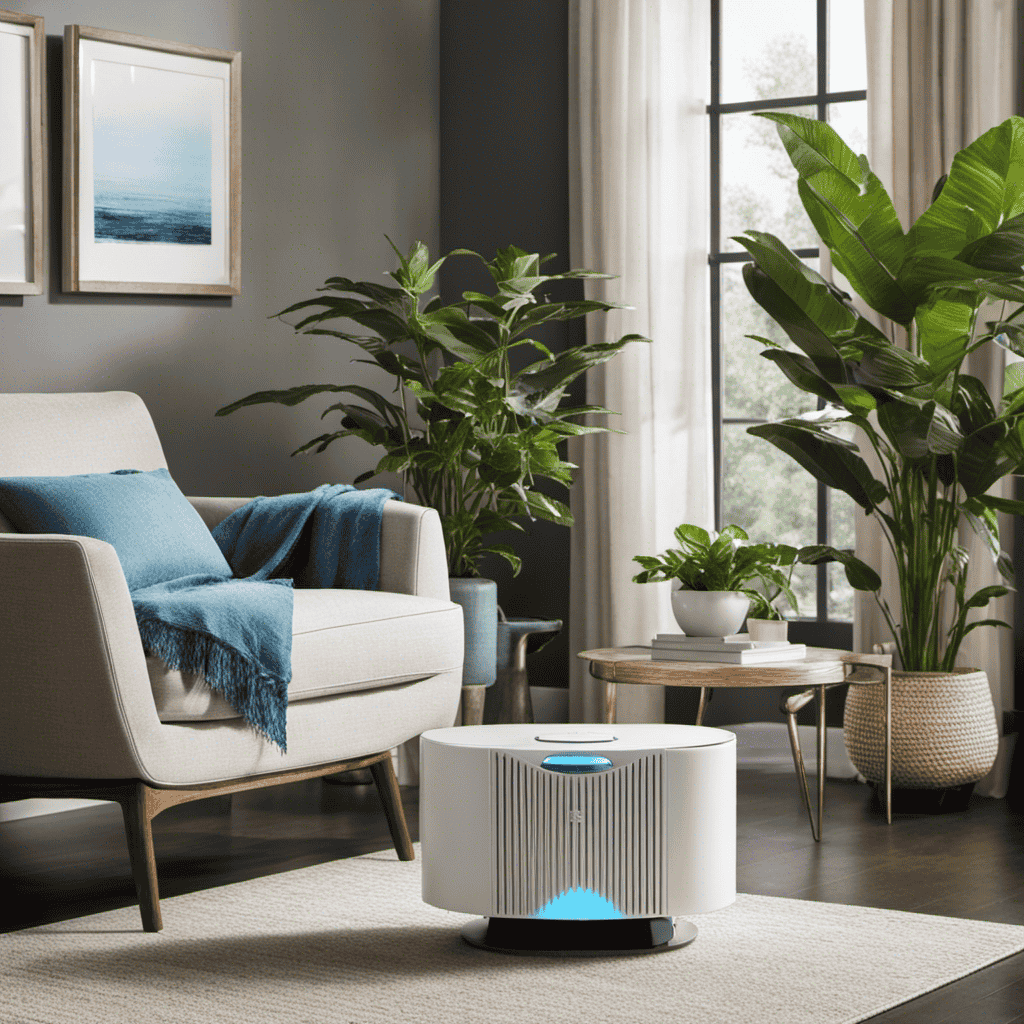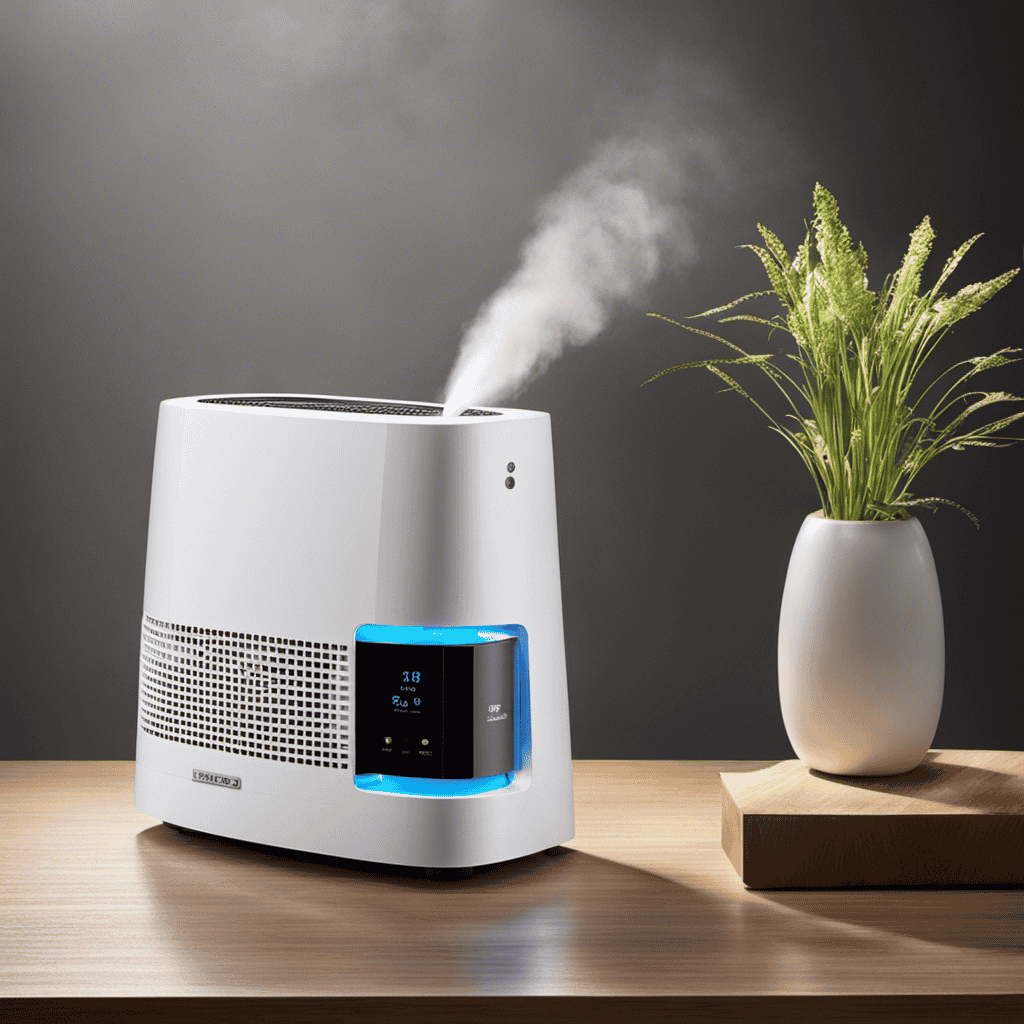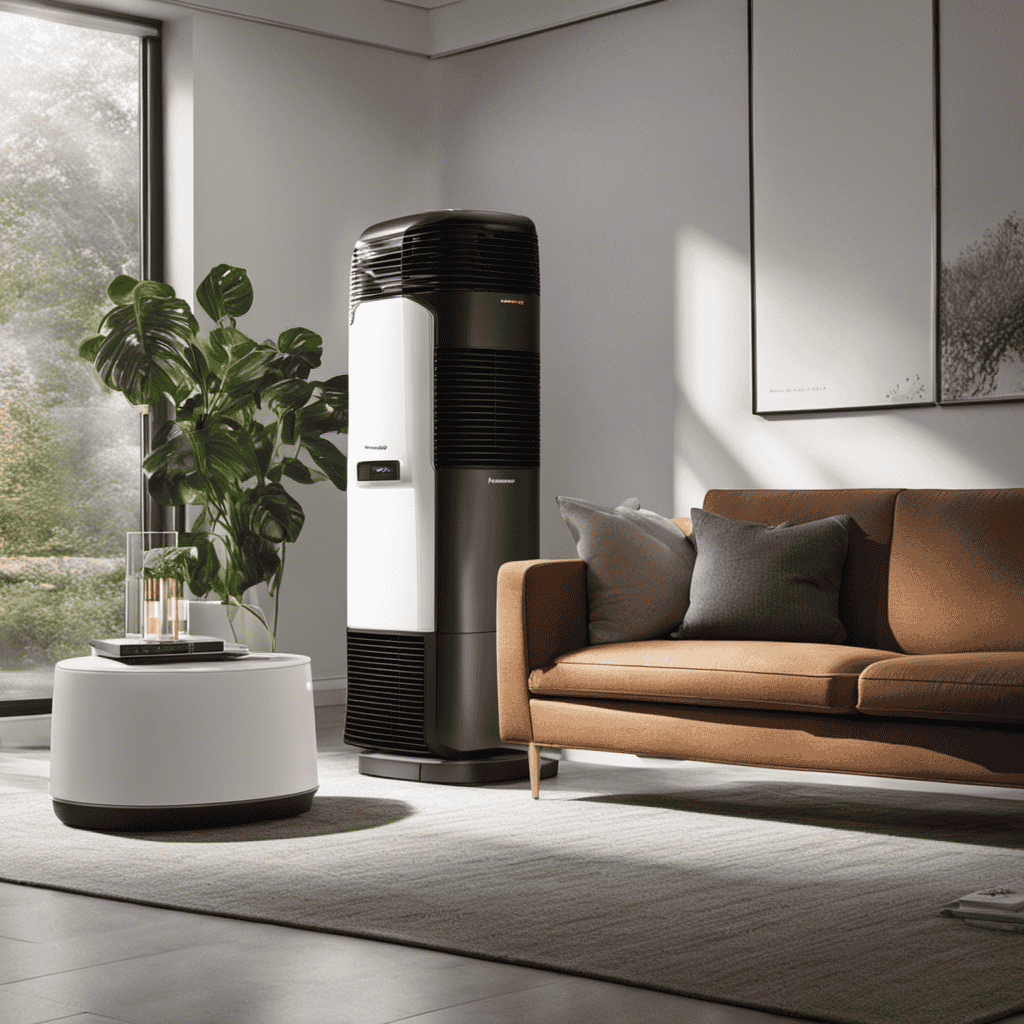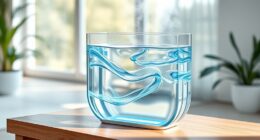As someone who is passionate about air purifiers, I frequently contemplate the ideal frequency for operating my reliable device. Through extensive research and testing, I have created this expert guide to assist other purifier enthusiasts in addressing this challenging dilemma.
From factors to consider, such as high pollen seasons and pet ownership, to the best times to run and the importance of maintenance, this article will provide all the knowledge needed to optimize your air purifier usage.
So, let’s dive in and demystify the question: how often should I run my air purifier?
Key Takeaways
- Recommended filter types and lifespan should be considered for optimal air purifier usage.
- The daily usage of an air purifier should be adjusted based on room size, air quality, and seasonal variations.
- Running the air purifier in a central location with proper airflow can maximize its effectiveness in improving air quality.
- Placing the air purifier in a central area, away from heat sources and direct sunlight, can help reduce energy consumption and improve efficiency.
Factors to Consider
When deciding how often to run your air purifier, there are several factors to consider. One important factor is the recommended filter types for your specific air purifier model. Different purifiers require different types of filters, such as HEPA filters or activated carbon filters, which have varying lifespans. It is crucial to follow the manufacturer’s recommendations on when to replace or clean the filters to ensure optimal performance.
Another factor to consider is the noise level impact of running the air purifier. While air purifiers are designed to operate quietly, some models may produce a noticeable noise, especially when running at higher speeds. It is important to find a balance between running the purifier long enough to effectively clean the air and minimizing any disruptions caused by noise.
In general, it is recommended to run your air purifier continuously, especially in areas with high pollution or allergens. This ensures that the air is constantly being purified and maintained at a high quality. However, if noise is a concern or if you are not in the room for an extended period, you can adjust the settings accordingly. For instance, you can set a timer to run the purifier for a few hours before you enter the room or during periods when you are away.
Considering the recommended filter types and the noise level impact, you can find the right balance and determine how often to run your air purifier based on your specific needs and circumstances.
Recommended Daily Usage
When it comes to using an air purifier, it’s important to understand the optimal run time for maximum effectiveness.
In this discussion, we will explore the recommended daily usage of air purifiers and the benefits they provide in improving air quality.
Additionally, we will delve into the impact of energy consumption, helping you make informed decisions about how to best utilize your air purifier.
Optimal Run Time
The optimal run time for an air purifier is typically determined by factors such as room size and air quality. To provide you with a more comprehensive understanding, let’s take a look at the table below:
| Factors | Nighttime | Daytime |
|---|---|---|
| Room Size | Smaller room | Larger room |
| Air Quality | Typically cleaner | Potentially poorer |
| Seasonal Variations | Consistent usage | Adjust based on need |
During nighttime, when the room is smaller and air quality is typically cleaner, running the air purifier continuously can help maintain a clean and fresh environment throughout the night. However, during daytime, when the room is larger and air quality may vary, it is recommended to adjust the run time based on the need. For example, if there are seasonal variations that affect air quality, you may want to run the air purifier for longer periods to combat any pollutants or allergens that may be present. Ultimately, it’s important to consider these factors to determine the optimal run time for your air purifier.
Air Quality Benefits
Running an air purifier can help improve the quality of the air in your home. It is important to consider the optimal placement of your air purifier to maximize its effectiveness.
Place it in a central location where it can circulate the air throughout the room. Keep it away from walls and furniture to ensure proper airflow.
Additionally, consider the noise level of your air purifier. Some models can be quite loud, which can be disruptive, especially if you plan to run it while sleeping or working. Look for air purifiers with adjustable fan speeds or a quiet mode to minimize noise.
Energy Consumption Impact
Placing an air purifier in an optimal location can help minimize energy consumption. When it comes to energy saving tips for air purifiers, there are a few key factors to consider.
First, make sure to place your purifier in a central area of your home to ensure maximum air circulation and coverage. This will allow the purifier to work more efficiently and reduce the need for running it constantly.
Additionally, keep the purifier away from heat sources or direct sunlight, as this can cause it to work harder and consume more energy.
By following these simple steps, you can not only save energy but also reduce the environmental impact of your air purifier.
Now, let’s discuss how to tackle the challenges of high pollen season.
High Pollen Season
During high pollen season, it’s important to run your air purifier more frequently. This will help keep the air in your home clean and allergen-free. Pollen allergies can cause a range of symptoms, including sneezing, itchy eyes, and congestion. By running your air purifier more often, you can reduce the amount of pollen particles in the air and alleviate these symptoms.
Here are three reasons why running your air purifier during high pollen season is crucial:
-
Relief from allergies: Running your air purifier can help remove pollen particles from the air, providing relief from seasonal allergies. Breathing in clean air can reduce symptoms such as sneezing, coughing, and congestion, allowing you to enjoy your home without discomfort.
-
Better sleep: Pollen allergies can make it challenging to get a good night’s sleep. By running your air purifier in your bedroom, you can create a clean and allergen-free environment, promoting better sleep and restfulness.
-
Improved indoor air quality: Pollen can find its way into your home through open windows, doors, and even on your clothing. Running your air purifier helps filter out these allergens, improving the overall indoor air quality and creating a healthier living space for you and your family.
Allergy Sufferers
For allergy sufferers, having an air purifier can provide relief from symptoms and create a healthier living environment. During high pollen seasons, such as spring, when allergens are at their peak, having an air purifier becomes even more crucial.
Air purifiers are designed to filter out pollen particles from the air, reducing exposure and minimizing allergic reactions. By capturing and trapping pollen, these devices can significantly reduce the amount of allergens circulating indoors.
As an expert in the field, I highly recommend air purifiers for allergy sufferers, especially during high pollen seasons. These devices can make a noticeable difference in the quality of air you breathe, helping to alleviate symptoms like sneezing, itchy eyes, and congestion. For pet owners, air purifiers are even more beneficial. They can effectively remove pet dander, a common allergen that can trigger allergies in sensitive individuals.
To get the most out of your air purifier, it is important to run it consistently. I suggest running the device 24/7, especially during high pollen seasons and if you have pets. This will ensure that the air in your home remains clean and allergen-free. Remember to regularly clean and replace the filters as instructed by the manufacturer to maintain optimal performance.
Pet Owners
As an expert in air purifiers, I understand the challenges that pet owners face when it comes to maintaining clean and fresh indoor air. Pets bring joy and companionship, but they also bring pet hair and odors. That’s why it’s important to address these issues and find the right balance for running your air purifier.
When it comes to pet hair, here are a few things to consider:
- Pet hair can accumulate quickly and become airborne, leading to allergies and breathing difficulties.
- Running your air purifier on a daily basis can help capture and remove pet hair from the air, keeping it clean and fresh.
- Investing in an air purifier with a high-efficiency particulate air (HEPA) filter is crucial for effectively trapping pet hair and other allergens.
Now, let’s talk about the litter box. While necessary for our furry friends, litter boxes can emit odors that can be unpleasant. Here’s how an air purifier can help:
- An air purifier with an activated carbon filter is highly effective in removing pet odors, including those from the litter box.
- Running your air purifier near the litter box can help eliminate odors and keep your home smelling fresh.
- It’s recommended to keep the air purifier running continuously to maintain clean and odor-free air.
Smokers or Vapers
If you’re a smoker or vaper, using an air purifier can help reduce the lingering smell of smoke or vapor in your home. Air purifiers are designed to capture and eliminate airborne particles, including those associated with secondhand smoke. These devices work by drawing in the air, trapping the contaminants, and then releasing clean, purified air back into the room.
When it comes to the lifespan of an air purifier, it can vary depending on several factors. The quality of the device, the frequency of use, and the level of pollutants in the air all play a role. On average, most air purifiers can last anywhere from 3 to 5 years with proper maintenance and regular filter replacements.
To ensure your air purifier is effectively reducing the smell of smoke or vapor, it’s important to follow the manufacturer’s recommendations for usage and maintenance. This includes regularly cleaning or replacing the filters, as they can become clogged and less efficient over time. Additionally, it’s a good idea to place the air purifier in a central location within the room to maximize its effectiveness.
Asthma and Respiratory Conditions
As an expert in air quality, I’m often asked about the effectiveness of air purifiers and the optimal frequency of usage.
When it comes to air purifier effectiveness, it’s important to consider factors such as the size of the room, the type of pollutants present, and the efficiency of the purifier itself.
Additionally, the optimal usage frequency of an air purifier will depend on the specific needs and conditions of the environment, with some individuals benefiting from continuous usage while others may only require intermittent use.
Air Purifier Effectiveness
The effectiveness of an air purifier can vary depending on factors such as room size and air quality. When considering the effectiveness of an air purifier, it is important to take into account the noise level, size, and proper placement of the device.
Here are three key points to consider:
-
Noise Level: A noisy air purifier can be disruptive and annoying, especially if you plan to use it in a bedroom or office space. Look for air purifiers with low noise levels, typically measured in decibels (dB), to ensure a quiet and peaceful environment.
-
Size: The size of the air purifier is crucial in determining its effectiveness. A small air purifier may not have the capacity to effectively clean the air in a large room, while an oversized air purifier may be unnecessary and consume more energy than needed. Choose the appropriate size based on the square footage of the room.
-
Placement: Proper placement of the air purifier is essential for maximizing its effectiveness. It is recommended to place the air purifier in a central location, away from obstacles or furniture that could obstruct airflow. Additionally, ensure that the air purifier is not placed near sources of pollutants, such as cooking areas or smoking areas.
Optimal Usage Frequency?
To get the most out of your air purifier, it’s recommended to use it regularly and follow the manufacturer’s guidelines for optimal usage frequency. The optimal usage duration for an air purifier depends on various factors, such as the size of the room, the level of pollutants present, and the specific model of the air purifier.
However, as a general rule of thumb, running your air purifier for 8-12 hours a day is typically sufficient to maintain clean air in your home or office. Additionally, it is generally best to run your air purifier during the times when you are most likely to be indoors, such as in the evening or at night. This ensures that you are breathing in clean air during the times when you are most exposed to indoor pollutants.
Now that we’ve covered optimal usage frequency, let’s dive into the next section about the air quality in your area.
Air Quality in Your Area
You should check the air quality in your area before deciding how often to run your air purifier. The air pollution levels in your surroundings can greatly impact your health, and understanding the quality of the air is crucial in determining the frequency of air purifier usage.
Here are three important things to consider:
-
Health Effects: Poor air quality can have severe health effects, especially for individuals with respiratory conditions. High levels of air pollution can trigger asthma attacks, allergies, and other respiratory problems. By checking the air quality, you can take necessary precautions to protect yourself and your loved ones.
-
Outdoor Factors: The air quality in your area can be influenced by various outdoor factors such as industrial emissions, traffic, and natural events like wildfires. Monitoring these factors will help you determine the periods when air pollution is at its peak and adjust your air purifier usage accordingly.
-
Seasonal Variations: Air pollution levels can vary throughout the year due to factors like weather conditions, temperature, and humidity. During certain seasons, such as summer or when pollen counts are high, air purifiers may need to be run more frequently to ensure cleaner indoor air.
Open Windows Vs. Closed Windows
Open windows can allow fresh air to circulate throughout your home, while closed windows can help maintain a controlled indoor environment. When it comes to deciding whether to keep your windows open or closed, there are a few factors to consider, such as the level of pollution in your area. Running your air purifier during high pollution days can help filter out harmful particles and improve the air quality inside your home. On the other hand, during low pollution days, opening your windows can be a great way to let in fresh air and reduce reliance on your air purifier.
To better understand the benefits and drawbacks of open windows versus closed windows, take a look at the table below:
| Open Windows | Closed Windows |
|---|---|
| Allows fresh air to circulate | Helps maintain controlled indoor environment |
| Potential exposure to outdoor pollutants | Reduces exposure to outdoor pollutants |
| Can help lower indoor humidity | Can help conserve energy and reduce noise |
Running at Night Vs. During the Day
When it comes to running an air purifier, it’s important to consider whether to use it at night or during the day.
Nighttime air purification can be beneficial for those who suffer from allergies or respiratory conditions, as it helps to remove pollutants and allergens from the air while we sleep.
However, there are also benefits to using an air purifier during the day, such as improving indoor air quality when windows are closed and reducing the spread of airborne viruses.
Therefore, it is important to find a balance between running the air purifier at night and during the day to maximize its effectiveness in creating a clean and healthy indoor environment.
Nighttime Air Purification
Running your air purifier at night can help improve the air quality in your home while you sleep. Here are three reasons why nighttime air purification is beneficial:
-
Reduced nighttime noise: Air purifiers are designed to operate quietly, allowing you to enjoy a peaceful and uninterrupted sleep. By eliminating pollutants and allergens, they create a calm and soothing environment in your bedroom.
-
Enhanced sleep quality: Breathing in clean air can result in better sleep quality. Air purifiers remove particles like dust, pet dander, and pollen, which can disrupt your sleep and trigger allergies or asthma symptoms.
-
Increased respiratory health: Running an air purifier at night helps to improve your respiratory health. It reduces the presence of airborne contaminants, allowing you to breathe in fresh and clean air throughout the night.
Transition: While nighttime air purification offers numerous benefits, there are also advantages to running your air purifier during the day. Let’s explore the benefits of daytime use.
Benefits of Daytime Use
While running an air purifier during sleep is beneficial for improving the quality of air in your bedroom, there are also significant advantages to using it during the daytime.
One of the main benefits is that it can help to maintain clean and fresh air throughout the day, especially in high traffic areas or rooms with poor ventilation.
Additionally, running an air purifier during the day can help to reduce the buildup of allergens, dust, and other pollutants that accumulate throughout the day.
Another advantage is that it can help to mask unwanted noise, such as traffic or construction sounds, providing a more peaceful and relaxing environment.
By using an air purifier during the day, you can ensure that you are breathing cleaner air and enjoying a quieter atmosphere.
Transitioning into the next section, it is important to strike a balance between day and night usage of your air purifier.
Balancing Day and Night
To maintain a healthy indoor environment, it’s important to find a balance between using an air purifier during the day and at night. While running an air purifier during the day can help remove allergens and pollutants from the air, using it at night can impact sleep quality.
Here are some key considerations to keep in mind:
-
Noise: Air purifiers can produce a humming sound, which may disturb sleep if you are sensitive to noise.
-
Airflow: Some air purifiers have a strong airflow that can create drafts, leading to discomfort during sleep.
-
Filter replacement: It’s essential to regularly replace air purifier filters, as dirty filters can reduce effectiveness and potentially cause health issues.
Finding the right balance between daytime and nighttime usage depends on individual preferences and needs. Consider using an air purifier during the day to improve air quality and limiting usage at night to minimize any potential disruptions to sleep.
Running in Different Rooms
You can place your air purifier in different rooms to ensure that you are getting the maximum benefit throughout your entire home. When it comes to running an air purifier in small spaces, such as bedrooms or home offices, it is generally recommended to run it continuously or for at least 8 hours a day. This ensures that the air in these confined spaces is constantly being cleaned and purified, providing you with clean and fresh air to breathe.
On the other hand, running an air purifier in large spaces, such as living rooms or open-plan areas, may require a different approach. In these areas, it is still important to run the air purifier for a significant amount of time to effectively clean the air. However, you may not need to run it continuously. Instead, running it for a few hours at a time, or intermittently throughout the day, can still provide you with the desired results.
It’s worth noting that the size and capacity of your air purifier will also play a role in determining how often and for how long you should run it. Larger air purifiers with higher clean air delivery rates may be able to clean the air more quickly and efficiently, allowing you to run them for shorter periods of time.
Overall, it is important to find a balance that works for your specific needs and the size of the space you are trying to purify. Regularly cleaning or replacing the filters in your air purifier will also help to maintain its efficiency and ensure that you are getting the most out of it.
Maintenance and Filter Replacement
It’s important to regularly maintain and replace the filters in your air purifier to ensure its efficiency and effectiveness. Filter maintenance plays a crucial role in prolonging the filter lifespan and maximizing the performance of your air purifier.
Here are a few key points to keep in mind:
-
Regular cleaning: Cleaning the filters on a monthly basis can help remove dust, allergens, and other particles that have accumulated on the surface. This will not only improve the air quality but also enhance the overall performance of the air purifier.
-
Replacement schedule: It is recommended to replace the filters every 6 to 12 months, depending on the manufacturer’s instructions and the level of air pollution in your area. Regularly replacing the filters ensures that your air purifier continues to effectively capture and remove contaminants from the air.
-
Proper handling: When replacing the filters, it’s important to follow the instructions provided by the manufacturer. This includes turning off the air purifier and ensuring that the new filter is correctly installed. Proper handling and installation will prevent any damage to the air purifier and ensure optimal performance.
Is There a Recommended Schedule for Running an Air Purifier?
Yes, there is a recommended schedule for running an air purifier. The ideal running an air purifier length is 24/7 to ensure continuous purification of the air. However, if running constantly is not feasible, it is recommended to run the air purifier for at least 8-10 hours a day for optimal air quality.
Frequently Asked Questions
Can I Run My Air Purifier Continuously Without Turning It Off?
I run my air purifier continuously without turning it off. It’s essential for air purifier maintenance to keep it running all the time.
Running the air purifier continuously ensures consistent air quality and maximizes the benefits it provides. The air purifier continuously filters out pollutants, allergens, and airborne particles, creating a healthier environment.
It’s a smart choice for anyone looking to improve indoor air quality and maintain a clean and fresh living space.
Is It Safe to Run My Air Purifier While I Am Sleeping?
It is safe to run your air purifier while you’re sleeping. In fact, it can provide several benefits.
Running it at night helps to ensure that you are breathing clean, purified air throughout the night. This can improve your sleep quality and overall well-being.
As for air purifier maintenance, it’s recommended to clean or replace the filters regularly to maintain its effectiveness.
Can I Use Multiple Air Purifiers in Different Rooms at the Same Time?
Using multiple air purifiers in different rooms can provide several benefits.
Firstly, it allows for targeted air purification throughout your home, ensuring clean and fresh air in every space.
Secondly, it can help to reduce the spread of pollutants and allergens, especially if you have pets or live in a highly polluted area.
Lastly, running air purifiers in multiple rooms can improve the overall air quality, providing a healthier living environment for you and your family.
How Long Does It Take for an Air Purifier to Improve Indoor Air Quality?
Using an air purifier in the workplace has numerous benefits. It helps improve indoor air quality by removing pollutants and allergens, creating a healthier environment for everyone.
Choosing the right size air purifier for your home is crucial. Consider the square footage of the room and the CADR (Clean Air Delivery Rate) to ensure optimal performance.
As for how often to run your air purifier, it depends on factors like air quality and personal preference.
Can an Air Purifier Help Reduce Cooking Odors in the Kitchen?
Running an air purifier regularly can greatly reduce cooking odors in the kitchen. The filters in the air purifier help to capture and remove the particles that cause these odors, leaving the air fresh and clean.
As for air purifier maintenance, it is recommended to run the device for a few hours each day, especially during cooking or when there are strong odors present. This will ensure that the air purifier continues to effectively remove odors and improve indoor air quality.
Is Running an Air Purifier 24/7 Necessary for Effective Air Purification?
Running an air purifier 24/7 may be necessary for effective air purification, but it also depends on the cost of running air purifier. Energy-efficient models can be run continuously without drastically increasing electricity bills. However, it’s important to consider the cost of electricity before deciding to run the purifier all day.
Conclusion
In conclusion, it all boils down to your specific needs and circumstances when running your air purifier. Factors such as high pollen season, allergies, pets, open or closed windows, and time of day should be taken into consideration. By understanding these factors and following the recommended daily usage, you can ensure that your air purifier is effectively improving the air quality in your home.
So, take control of your indoor environment and breathe easy with a well-maintained air purifier. After all, clean air is the key to a healthy life.










